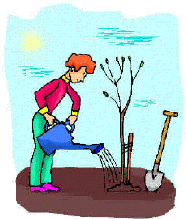BACKGROUND:
 Students by the 6th grade should be
familiar with the mechanism of the water cycle. They might not realize
the significance of water to enable life to exist on Earth. The following
is a summary of the importance of water to life. Students by the 6th grade should be
familiar with the mechanism of the water cycle. They might not realize
the significance of water to enable life to exist on Earth. The following
is a summary of the importance of water to life.
- Water remains a liquid over a very
wide temperature range, namely, a range of 100C° between freezing
and vaporization. This spans the temperatures of most parts
of the Earth where life can occur.
- Water has a very high specific heat,
which means that it can absorb or lose much heat before its temperature
changes. This is important in maintaining body heat in mammals, such
as ourselves.
- Water has a high latent heat of vaporization.
For this reason, water evaporates slowly from ponds and lakes, where many
life forms are dependent on it.
- Water is less dense in its solid
state than in its liquid state, so that ice floats instead of sinking.
This property permits life to develop in polar regions and subpolar regions
where ice floats and allows life to continue living below the surface.
If ice were heavier than water, it would sink, and more ice would form
on top of it. As a result, all life in the waters would be trapped
in the ice in the many areas of the world where it gets cold enough to
freeze water.
- Water is a remarkable solvent not
only for the reasons mentioned above but also for gases such as oxygen
and carbon dioxide. The oxygen must be soluble in the water phase
of the living cell in order for it to be used for oxidation of food.
At the same time, another gas, carbon dioxide, must also be soluble to
escape to the outside of the cell, from where it travels to the lungs to
get expired.
- Water exhibits surface tension.
The molecules of water on the surface of a calm and quiet pond tend to
be drawn into the liquid, so that the liquid surface is taut, like a sheet
of rubber drawn over the open mouth of a jar. This tautness is called
surface tension. It can support small objects like a sewing needle.
This "skin" on the water can also cause a handicap to mayflies and caddisflies
that try to emerge from their juvenile images. It also can trap flying
insects that accidentally fall into the water and are unable to fly out.
- Water exhibits viscosity. One
can observe the effects of viscosity alongside a stream or river with uniform
banks. The water along the banks is nearly still, while the current
in the center may be swift. This resistance between the layers is
called viscosity. This property allows smaller fish to live
near the shore, while larger fish are able to swim efficiently in strong
currents. Viscosity is also responsible for the formation of eddies,
creating turbulence that leads to good mixing of air in the water and more
uniform distribution of microscopic organisms.
PROCEDURE:
-
The water cycle can be very
simple, but the more times a student is introduced to the concepts, the
more involved the cycle becomes. The movement of water involves more
than just evaporation and precipitation. Go over the major parts
of the water cycle as illustrated by the diagram below.
-
evaporation - the changing of liquid to water
vapor
-
condensation - the changing of water vapor
to a liquid
-
precipitation - forms of water vapor that
are heavy enough to fall to the Earth's surface such as rain, snow,
sleet, hail, and fog
-
infiltration - the process by which water seeps
into the soil
-
water table - the level below which the ground is
saturated with water
-
lake - a body of water larger than a pond and too
deep in parts for rooted plants to live
-
river - a natural stream of water larger than
a creek and emptying into an ocean, lake, or another river
-
ocean - the bodies of salt water that cover nearly
three fourths of the surface of the earth
-
groundwater - water found below the surface of the
Earth
-
runoff - water that flows on the surface or
through the ground into streams, rivers, lakes and oceans
-
transpiration - the evaporation of water from the
leaves of plants

-
Use the worksheet and have the students
draw in some of the components to make the diagram easier to understandable.
You may want the students to write a paragraph on the water cycle, taking
information from the worksheet.
-
Use the online poem of Dr. Drippy to illustrate how poems can be a fun
way to learn the content of the water cycle. Students should read Dr.
Drippy. This poem is based on key words from the water cycle. Challenge
students to write their own poem or limerick on the water cycle.
A poem is a composition of a verse that uses rhymes to express a
subject in an artistic fashion. Students can either have it rhyming or
not depending on how they us their imagination.
You may also want to assign students to create a limerick. A limerick
is kind of a humorous verse of 5 lines in which the first and second
lines rhyme with the fifth line. The shorter third line rhymes with the
shorter fourth line.
You may want to pair up students, one with artistic talents and the
other the writer.
|